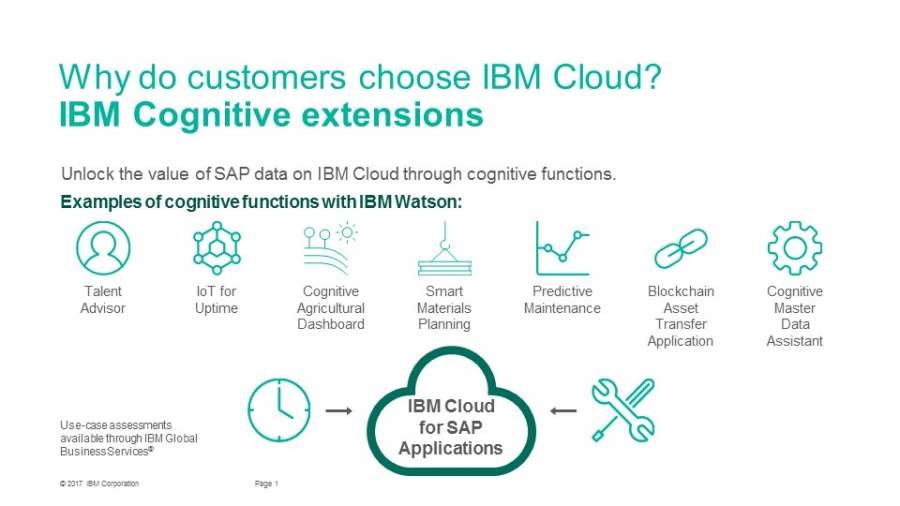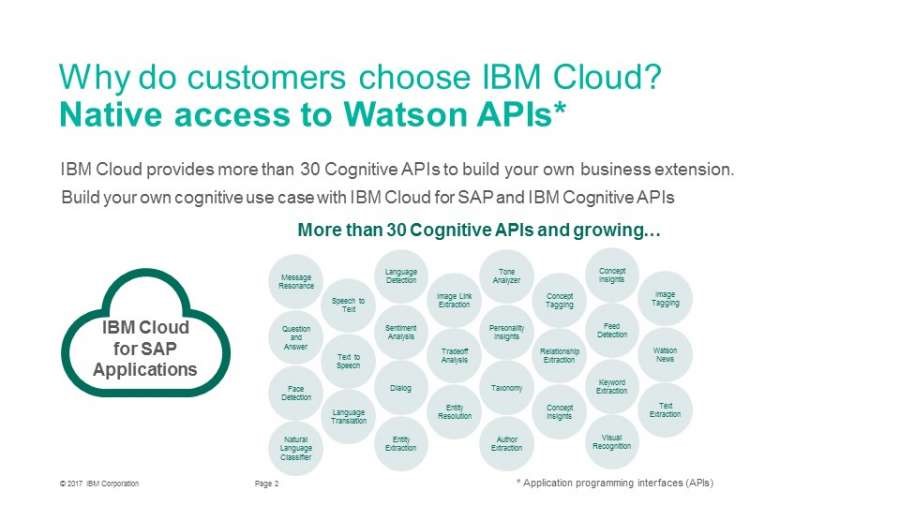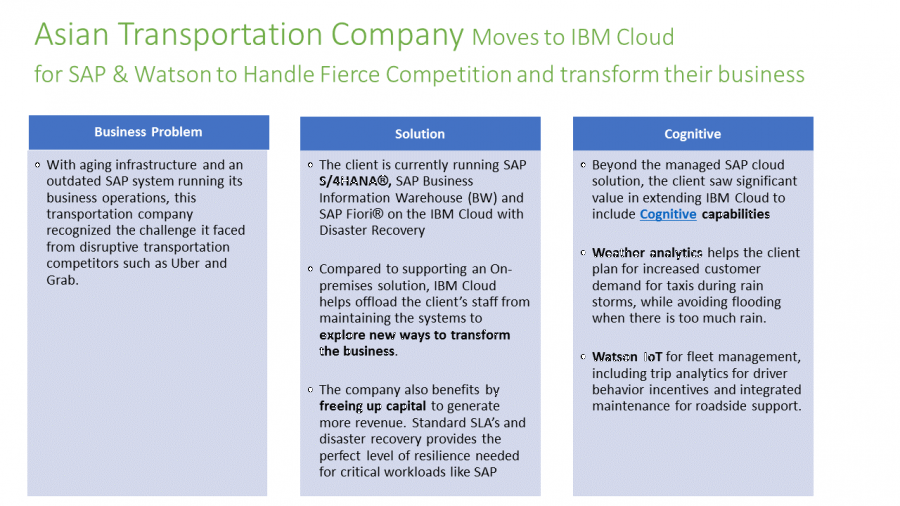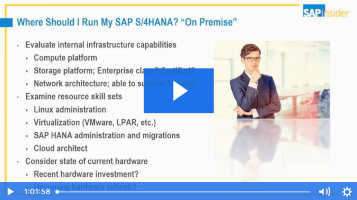Build Industry Solutions with SAP S/4HANA and IBM Watson deployed on IBM Cloud
Manufacturing company Mondi is using SAP S/4HANA, IBM Cloud and Watson APIs to automate month end processing. An Asian transportation company transformed to ward off stiff competition from Uber and Grab by combining IBM Weather data with Cognitive Fleet management. How can you create new solutions for your industry with SAP and Watson Solutions? What are common use cases for machine learning, automation, and internet of things? What are the benefits of running SAP and Watson solutions on IBM Cloud?
Read the Q&A transcript with IBM experts including Sanjay Das, Digital Transformation Leader for Europe and Joe Gallego, Global Technical Enablement Leader, IBM Cloud for SAP Applications to learn more about how industry solutions are created and the benefits of running SAP and Watson solutions on IBM Cloud.
Matthew Shea: Hello, and welcome to today’s chat!
We will be discussing how to build industry solutions with SAP S/4HANA and IBM Watson deployed on IBM Cloud.
I am excited to be joined by the following experts from IBM:
- Rahul Ravi Jha, Team Lead and Architect – Lab for SAP Solution Global Business Services
- Sanjay Das, Digital Transformation Leader for Europe
- Joe Gallego, Offering Manager, IBM Cloud for SAP Applications
Comment From Alex: What are the short-term and long-term benefits of automation?
Sanjay: Automation is about taking robotic activities from the human workforce. We have been doing this successfully on factory shop floors for a while now. Now it is time to get the benefits for the back-office and front-office business processes as well.
The Immediate short-term benefits are:
- Freeing up resources to do more strategic work
- Reduction of manual- and data-related errors and an increase in compliance and visibility
Medium-term benefits are:
- Better use of data and being more data driven
- Improving customer experience
- Creating a platform for improved business outcomes through artificial intelligence (AI)
Comment From Yi: Which type of infrastructure as a service (IaaS) is best to run SAP with Watson?
Joe Gallego: Watson APIs can be integrated with any IaaS vendor. Running SAP on IBM Cloud would provide better latency since they run from the same data centers. Also IBM Cloud for SAP Applications is a specific offering tailored for SAP applications with three different managed services levels:
- IaaS
- Managed OS
- Managed SAP Basis
Comment From BM: What kind of business scenarios are supported by AI (Watson) and SAP?
Joe Gallego: You can run SAP and Watson for basically any industry. IBM has predefined SAP-Watson scenarios such as Predictive Maintenance and Smart Materials Planning. You can also build your own business scenario using Watson APIs.
Comment From Kiki: Where do you see automation leading to in the future?
Sanjay: Let me answer this in the context of one of our customers in Europe. I presented the month-end cognitive automation solution that we developed with the customer. The focus for a while has been on automation of its shop floor. The plants are largely automated, controlled, and monitored via sensor data. After the month-end closing solution is implemented, it will be targeting on bringing the value into other business processes as well. It sees automation as a way to free up resources to focus on strategic areas like improved customer experience and innovation. Cognitive automation is seen as a way to make more data-driven decisions and more orchestrated processes. In the future its employees will have more time to talk to each other and to collaborate and co-innovate for satisfied customers and shareholders.
Figure 1 shows more detail about IBM cognitive extensions.

Figure 1 IBM cognitive extensions
Rahul Jha: SAP and Watson solutions that can be offered are Talent Advisor (SuccessFactors [SF] extensions on SAP Cloud Platform, cognitive procurement using Watson Explorer, and IBM Metro Pulse Application [for retail clients]). There are around 80+ proofs of concept (PoCs) created on IBM and SAP integration and there are initiatives that are being built using SAP S/4HANA’s digital core and IBM’s Bluemix.
Comment From JR: What’s the success formula of automation and why now?
Sanjay: We feel that the successful formula is primarily business and IT working together. This is about transformation of business. We need to consider that only bringing in the bots will not be sufficient if we do not consider the change management impacts and process optimization opportunities. The other aspect is weaving in AI to the solution. Automation can speed up a few steps but unless there is cognitive troubleshooting and orchestration of the end-to-end process, the benefit realization will not be optimal. Finally, it is important to identify use cases and prioritize the use case roadmap for delivery.
For many companies we have started with the CFO’s office and month-end closure as the use case. This can now be extended to more use cases with the CFO’s office and also to other process areas such as Marketing and HR.
Comment From RK: Does Watson run with SAP ERP Central Component (ECC) on a non-SAP HANA database environment?
Joe Gallego: Watson provides more than 30 cognitive APIs that can be integrated with any SAP solution. You would just need to call the API from SAP.
Figure 2 shows the current cognitive APIs.

Figure 2 Cognitive APIs
Comment From RK: What is the typical time frame to build a new business scenario in SAP and Watson? What are the prerequisites to building a scenario?
Sanjay: Let me start with your second question first 🙂
We recommend a set of design thinking sessions to identify opportunities, use cases, and their roadmap. Rapid prototyping can be used for prioritized use cases to showcase how the end solution will look. Once the green signal is received the prototype will be converted to a productive solution through an agile approach. We recommend delivery of a minimum viable product (MVP) first and then bringing in further improvements.
The technical prerequisites are integration of SAP (such as SAP S/4HANA or ECC) with IBM Bluemix to access the Watson APIs and other applications like Blue Prism the robotics process automation (RPA) engine, we used for the month-end closing cognitive automation solution.
Regarding the time frame of building the use case, typically we deliver in weeks rather than months. As I already mentioned we focus on an MVP first and then add further features and enhancements.
Comment From Greg: What is the best way to get started with an AI project for an SAP client?
Rahul Jha: One of the focus area for AI in SAP is with SAP Leonardo as SAP is investing heavily on SAP AI in its cloud portfolio. IBM is leveraging RPA and Watson to build solutions to automate the transactions in an SAP environment. Apart from this IBM is also investing in building predictive solutions (that cater to the advanced analytics areas) with SAP.
IBM’s Watson offerings (such as Watson Explorer) can be used for crawling the data from SAP data and providing cognitive capabilities. You can check out the various offerings from IBM’s Bluemix for the machine learning (ML) projects using Spark, Python models and SPSS (mostly in the case of predictive modeling)
You can refer to the ML/Data Science link from IBM DS.
However, as Sanjay has mentioned, the key to success is identification of use cases and a roadmap balancing value versus effort (risk).
Comment From Jeison: What skill level do I need (or does my team need) to take advantage of AI?
Sanjay: The teaming of business and IT delivers success here. Business brings in business insight, challenges, and their view on opportunities while IT brings in SAP technical and functional knowledge about how AI can optimize the outcome and how to integrate Watson APIs with SAP.
As such APIs are providing intelligence (e.g., you can send a customer an email text and the Watson API can send you back with the customer ‘sentiment’). Typically, you do not need pure AI skills. Rather you need people who can integrate the insight into SAP processes. Hence, knowledge of business processes and SAP functional and technical skills will come in very handy.
Comment From Jason: Are there effectively thresholds of size/scale that make cloud a better solution versus on premise? Is there a top end of that scale, whereby the volume is simply too large to be effectively transported via cloud?
Joe Gallego: You can run large-scale SAP HANA and non-SAP HANA databases in IBM Cloud—up to 8TB SAP HANA nodes today and very soon above that, and 18 TB non-SAP HANA with up to 200.000 SAPS per system. In the AI side (Watson) there is no need for configuring sizes.
Comment From Prasad: We are planning to use the SAP Leonardo platform for our Internet of Things (IoT) solutions. Is IBM working with SAP to seamlessly make Watson API calls from Leonardo as needed?
Sanjay: IBM is working closely with SAP on Watson integration with SAP applications including Leonardo. A good example is our partnership on Ariba, which was announced at SAPPHIRE Orlando 2017 (https://www.ariba.com/about/news-and-press/sap-ariba-and-ibm-join-forces-to-transform-procurement-with-sap-leonardo-and-watson).
Comment From Martin: How can Watson assist IT administrators in preventing a system performance degradation or a system outage by: 1. predicting issues before they happen on SAP HANA systems?, 2. recommending solutions for these potential issues?, and 3. executing a recommended solution selected by an SAP Basis administrator?
Sanjay: IBM has developed specific solutions focusing on IT administration using predictive models. These integrate well with SAP systems like SAP HANA and/or ECC. On top you can consider using Watson and Blue Prism to monitor and fix system issues proactively.
Comment From Gus: How can AI help business processes?
Joe Gallego: You can run SAP and Watson for basically any industry and cognitive use case. IBM has predefined SAP-Watson scenarios such as Predictive Maintenance and Smart Materials Planning. You can also build your own business scenario using Watson APIs. For example, there is an Asian transportation company that uses SAP with Watson Weather and when it rains the system automatically adds more taxi drivers in service to anticipate the demand (Figure 3).

Figure 3 A transportation company in the cloud
Comment From RK: Where do we have the maximum benefits of deploying Watson in addition to SAP S/4HANA─shop floor operations or corporation applications?
Sanjay: It will depend on your company’s challenges and opportunities. I have personally been involved in both types of use cases. However, the priorities were different as the companies’ situations were different. For the best outcome, my recommendation is to identify the use cases and work out a roadmap. Change management and stakeholder sponsorship can come out to be more decisive than the technical considerations. If you get good support from the plant manager, the shop floor use cases will succeed and the same goes for the CFO’s sponsorship for corporate processes such as month-end closing. If you get equal support from both, it is a very good problem to have :-).
Comment From Sushma: There are so many companies working on analytics. How will SAP decide whom to integrate such as IBM Watson. Are SAP’s analytics compatible with all cloud analytics?
Rahul Jha: SAP Cloud Platform and Cloud Foundry offer enterprises the freedom to choose their underlying cloud infrastructure provider. As it is based on platform as a service (PaaS) and offers multi-cloud options, the cloud vendors who have PaaS service will be the preferred choice.
Through the Cloud Provider Interface (CPI) it is possible to run Cloud Foundry on various infrastructures. SAP has teamed up with SUSE to co-lead the open-source development of the BOSH OpenStack CPI (see the SAP leading Cloud Foundry project “BOSH OpenStack Cloud Provider Interface”). Many of the big IaaS providers provide their own CPI implementations (e.g., Amazon Web Services [AWS], Microsoft Azure, and Google Cloud Platform).
IBM’s Bluemix, which is also Cloud Foundry-based, has a variety of deployment models and SAP recently announced IBM Bluemix is certified to be used with SAP HANA and SAP NetWeaver.
The below blog details it:
IBM Bluemix IaaS certified for SAP HANA and SAP NetWeaver applications
Comment From Prabhu: How do you get started building a prototype of SAP and Watson on IBM Cloud? Is there a free trial option available?
Joe Gallego: You can run SAP on premise or on cloud and integrate with Watson. You can find a free trial for the AI platform here.
Comment From Rosa: What integration tool is required to integrate IBM predictive models with SAP systems? Of course, Watson and blueprism are automation tools and sit on top of ERP systems.
Sanjay: You can integrate with IBM Bluemix to access Watson APIs, which can help in predictive models. You can also use IBM SPSS Statistics for creating predictive models if you choose to use it rather than SAP HANA Predictive Analytics Library (PAL).
Comment From Prabhu: Can I build and deploy an SAP HANA native application on IBM Cloud now?
Joe Gallego: Yes, you can deploy and run native SAP HANA applications on IBM Cloud. You can find the certified SAP HANA IaaS here.
Comment From Prabhu: SAP Cloud Platform provides inbuilt Edge services for analytics and machine learning. What is the special need Watson APIs from IBM Cloud can fulfill? Any unique service that IBM Cloud provides?
Rahul Jha: Watson has been running for many years and has a very mature coverage for the ML APIs. The question is not about sticking to one solution but to leverage a portfolio of APIs as per the requirement of a use case. The cloud model provides flexibility and scalability to use APIs from multiple sources.
IBM Bluemix has many services in terms of Analytics, DevOps, Platform, Security, Watson, and a huge list of boiler-plates to kick start your development. IBM Bluemix also has application services, mobile services, integration services, and in-built financial services. Along with the IBM’s API, you can also use the third-party APIs from IBM Bluemix. This is a unique feature for the IBM Bluemix cloud development.
As for IOT, according to IDC analysis and buyer perceptions, IBM is a leader for IoT platforms. IBM Bluemix IOT provides in-built analytics in the areas of predictive, cognitive (ML, natural language processing, video/image analytics, and text analytics), real time, and Edge analytics. (IBM’s Watson IoT does include various capabilities within each of these constructs within the platform; however, some capabilities, such as machine learning and security analytics, are add-on products.)
IBM offers a gateway software development kit (SDK) that can be pre-embedded into hardware for edge capabilities.
Following is the link for the Watson Services for API offerings: https://www.ibm.com/watson/products-services/.
Comment From RK: This is a licensing question. In addition to an SAP S/4HANA license, companies have to buy a separate license for Watson, right? If yes, what is the licensing model? Is it based on users, transactions, or database size?
Rahul Jha: Yes. You would need to take a license for IBM Bluemix. IBM Bluemix lets you choose the right compute model for your workload and quickly deploy it over 120 services–including Watson services. The pricing is based on the run time and container size for IBM Bluemix. The APIs from Watson Developer Cloud are priced on the usage (i.e., number of API calls).
https://www.ibm.com/cloud-computing/bluemix/pricing
You can calculate the usage pricing using the pricing calculator:
Joe Gallego: Thank you all for joining!!
Matthew Shea: Thank you Joe, Sanjay, and Rahul for all your insightful answers today!
Manufacturing company Mondi is using SAP S/4HANA, IBM Cloud and Watson APIs to automate month end processing. An Asian transportation company transformed to ward off stiff competition from Uber and Grab by combining IBM Weather data with Cognitive Fleet management. How can you create new solutions for your industry with SAP and Watson Solutions? What are common use cases for machine learning, automation, and internet of things? What are the benefits of running SAP and Watson solutions on IBM Cloud?
Read the Q&A transcript with IBM experts including Sanjay Das, Digital Transformation Leader for Europe and Joe Gallego, Global Technical Enablement Leader, IBM Cloud for SAP Applications to learn more about how industry solutions are created and the benefits of running SAP and Watson solutions on IBM Cloud.
Matthew Shea: Hello, and welcome to today’s chat!
We will be discussing how to build industry solutions with SAP S/4HANA and IBM Watson deployed on IBM Cloud.
I am excited to be joined by the following experts from IBM:
- Rahul Ravi Jha, Team Lead and Architect – Lab for SAP Solution Global Business Services
- Sanjay Das, Digital Transformation Leader for Europe
- Joe Gallego, Offering Manager, IBM Cloud for SAP Applications
Comment From Alex: What are the short-term and long-term benefits of automation?
Sanjay: Automation is about taking robotic activities from the human workforce. We have been doing this successfully on factory shop floors for a while now. Now it is time to get the benefits for the back-office and front-office business processes as well.
The Immediate short-term benefits are:
- Freeing up resources to do more strategic work
- Reduction of manual- and data-related errors and an increase in compliance and visibility
Medium-term benefits are:
- Better use of data and being more data driven
- Improving customer experience
- Creating a platform for improved business outcomes through artificial intelligence (AI)
Comment From Yi: Which type of infrastructure as a service (IaaS) is best to run SAP with Watson?
Joe Gallego: Watson APIs can be integrated with any IaaS vendor. Running SAP on IBM Cloud would provide better latency since they run from the same data centers. Also IBM Cloud for SAP Applications is a specific offering tailored for SAP applications with three different managed services levels:
- IaaS
- Managed OS
- Managed SAP Basis
Comment From BM: What kind of business scenarios are supported by AI (Watson) and SAP?
Joe Gallego: You can run SAP and Watson for basically any industry. IBM has predefined SAP-Watson scenarios such as Predictive Maintenance and Smart Materials Planning. You can also build your own business scenario using Watson APIs.
Comment From Kiki: Where do you see automation leading to in the future?
Sanjay: Let me answer this in the context of one of our customers in Europe. I presented the month-end cognitive automation solution that we developed with the customer. The focus for a while has been on automation of its shop floor. The plants are largely automated, controlled, and monitored via sensor data. After the month-end closing solution is implemented, it will be targeting on bringing the value into other business processes as well. It sees automation as a way to free up resources to focus on strategic areas like improved customer experience and innovation. Cognitive automation is seen as a way to make more data-driven decisions and more orchestrated processes. In the future its employees will have more time to talk to each other and to collaborate and co-innovate for satisfied customers and shareholders.
Figure 1 shows more detail about IBM cognitive extensions.

Figure 1 IBM cognitive extensions
Rahul Jha: SAP and Watson solutions that can be offered are Talent Advisor (SuccessFactors [SF] extensions on SAP Cloud Platform, cognitive procurement using Watson Explorer, and IBM Metro Pulse Application [for retail clients]). There are around 80+ proofs of concept (PoCs) created on IBM and SAP integration and there are initiatives that are being built using SAP S/4HANA’s digital core and IBM’s Bluemix.
Comment From JR: What’s the success formula of automation and why now?
Sanjay: We feel that the successful formula is primarily business and IT working together. This is about transformation of business. We need to consider that only bringing in the bots will not be sufficient if we do not consider the change management impacts and process optimization opportunities. The other aspect is weaving in AI to the solution. Automation can speed up a few steps but unless there is cognitive troubleshooting and orchestration of the end-to-end process, the benefit realization will not be optimal. Finally, it is important to identify use cases and prioritize the use case roadmap for delivery.
For many companies we have started with the CFO’s office and month-end closure as the use case. This can now be extended to more use cases with the CFO’s office and also to other process areas such as Marketing and HR.
Comment From RK: Does Watson run with SAP ERP Central Component (ECC) on a non-SAP HANA database environment?
Joe Gallego: Watson provides more than 30 cognitive APIs that can be integrated with any SAP solution. You would just need to call the API from SAP.
Figure 2 shows the current cognitive APIs.

Figure 2 Cognitive APIs
Comment From RK: What is the typical time frame to build a new business scenario in SAP and Watson? What are the prerequisites to building a scenario?
Sanjay: Let me start with your second question first 🙂
We recommend a set of design thinking sessions to identify opportunities, use cases, and their roadmap. Rapid prototyping can be used for prioritized use cases to showcase how the end solution will look. Once the green signal is received the prototype will be converted to a productive solution through an agile approach. We recommend delivery of a minimum viable product (MVP) first and then bringing in further improvements.
The technical prerequisites are integration of SAP (such as SAP S/4HANA or ECC) with IBM Bluemix to access the Watson APIs and other applications like Blue Prism the robotics process automation (RPA) engine, we used for the month-end closing cognitive automation solution.
Regarding the time frame of building the use case, typically we deliver in weeks rather than months. As I already mentioned we focus on an MVP first and then add further features and enhancements.
Comment From Greg: What is the best way to get started with an AI project for an SAP client?
Rahul Jha: One of the focus area for AI in SAP is with SAP Leonardo as SAP is investing heavily on SAP AI in its cloud portfolio. IBM is leveraging RPA and Watson to build solutions to automate the transactions in an SAP environment. Apart from this IBM is also investing in building predictive solutions (that cater to the advanced analytics areas) with SAP.
IBM’s Watson offerings (such as Watson Explorer) can be used for crawling the data from SAP data and providing cognitive capabilities. You can check out the various offerings from IBM’s Bluemix for the machine learning (ML) projects using Spark, Python models and SPSS (mostly in the case of predictive modeling)
You can refer to the ML/Data Science link from IBM DS.
However, as Sanjay has mentioned, the key to success is identification of use cases and a roadmap balancing value versus effort (risk).
Comment From Jeison: What skill level do I need (or does my team need) to take advantage of AI?
Sanjay: The teaming of business and IT delivers success here. Business brings in business insight, challenges, and their view on opportunities while IT brings in SAP technical and functional knowledge about how AI can optimize the outcome and how to integrate Watson APIs with SAP.
As such APIs are providing intelligence (e.g., you can send a customer an email text and the Watson API can send you back with the customer ‘sentiment’). Typically, you do not need pure AI skills. Rather you need people who can integrate the insight into SAP processes. Hence, knowledge of business processes and SAP functional and technical skills will come in very handy.
Comment From Jason: Are there effectively thresholds of size/scale that make cloud a better solution versus on premise? Is there a top end of that scale, whereby the volume is simply too large to be effectively transported via cloud?
Joe Gallego: You can run large-scale SAP HANA and non-SAP HANA databases in IBM Cloud—up to 8TB SAP HANA nodes today and very soon above that, and 18 TB non-SAP HANA with up to 200.000 SAPS per system. In the AI side (Watson) there is no need for configuring sizes.
Comment From Prasad: We are planning to use the SAP Leonardo platform for our Internet of Things (IoT) solutions. Is IBM working with SAP to seamlessly make Watson API calls from Leonardo as needed?
Sanjay: IBM is working closely with SAP on Watson integration with SAP applications including Leonardo. A good example is our partnership on Ariba, which was announced at SAPPHIRE Orlando 2017 (https://www.ariba.com/about/news-and-press/sap-ariba-and-ibm-join-forces-to-transform-procurement-with-sap-leonardo-and-watson).
Comment From Martin: How can Watson assist IT administrators in preventing a system performance degradation or a system outage by: 1. predicting issues before they happen on SAP HANA systems?, 2. recommending solutions for these potential issues?, and 3. executing a recommended solution selected by an SAP Basis administrator?
Sanjay: IBM has developed specific solutions focusing on IT administration using predictive models. These integrate well with SAP systems like SAP HANA and/or ECC. On top you can consider using Watson and Blue Prism to monitor and fix system issues proactively.
Comment From Gus: How can AI help business processes?
Joe Gallego: You can run SAP and Watson for basically any industry and cognitive use case. IBM has predefined SAP-Watson scenarios such as Predictive Maintenance and Smart Materials Planning. You can also build your own business scenario using Watson APIs. For example, there is an Asian transportation company that uses SAP with Watson Weather and when it rains the system automatically adds more taxi drivers in service to anticipate the demand (Figure 3).

Figure 3 A transportation company in the cloud
Comment From RK: Where do we have the maximum benefits of deploying Watson in addition to SAP S/4HANA─shop floor operations or corporation applications?
Sanjay: It will depend on your company’s challenges and opportunities. I have personally been involved in both types of use cases. However, the priorities were different as the companies’ situations were different. For the best outcome, my recommendation is to identify the use cases and work out a roadmap. Change management and stakeholder sponsorship can come out to be more decisive than the technical considerations. If you get good support from the plant manager, the shop floor use cases will succeed and the same goes for the CFO’s sponsorship for corporate processes such as month-end closing. If you get equal support from both, it is a very good problem to have :-).
Comment From Sushma: There are so many companies working on analytics. How will SAP decide whom to integrate such as IBM Watson. Are SAP’s analytics compatible with all cloud analytics?
Rahul Jha: SAP Cloud Platform and Cloud Foundry offer enterprises the freedom to choose their underlying cloud infrastructure provider. As it is based on platform as a service (PaaS) and offers multi-cloud options, the cloud vendors who have PaaS service will be the preferred choice.
Through the Cloud Provider Interface (CPI) it is possible to run Cloud Foundry on various infrastructures. SAP has teamed up with SUSE to co-lead the open-source development of the BOSH OpenStack CPI (see the SAP leading Cloud Foundry project “BOSH OpenStack Cloud Provider Interface”). Many of the big IaaS providers provide their own CPI implementations (e.g., Amazon Web Services [AWS], Microsoft Azure, and Google Cloud Platform).
IBM’s Bluemix, which is also Cloud Foundry-based, has a variety of deployment models and SAP recently announced IBM Bluemix is certified to be used with SAP HANA and SAP NetWeaver.
The below blog details it:
IBM Bluemix IaaS certified for SAP HANA and SAP NetWeaver applications
Comment From Prabhu: How do you get started building a prototype of SAP and Watson on IBM Cloud? Is there a free trial option available?
Joe Gallego: You can run SAP on premise or on cloud and integrate with Watson. You can find a free trial for the AI platform here.
Comment From Rosa: What integration tool is required to integrate IBM predictive models with SAP systems? Of course, Watson and blueprism are automation tools and sit on top of ERP systems.
Sanjay: You can integrate with IBM Bluemix to access Watson APIs, which can help in predictive models. You can also use IBM SPSS Statistics for creating predictive models if you choose to use it rather than SAP HANA Predictive Analytics Library (PAL).
Comment From Prabhu: Can I build and deploy an SAP HANA native application on IBM Cloud now?
Joe Gallego: Yes, you can deploy and run native SAP HANA applications on IBM Cloud. You can find the certified SAP HANA IaaS here.
Comment From Prabhu: SAP Cloud Platform provides inbuilt Edge services for analytics and machine learning. What is the special need Watson APIs from IBM Cloud can fulfill? Any unique service that IBM Cloud provides?
Rahul Jha: Watson has been running for many years and has a very mature coverage for the ML APIs. The question is not about sticking to one solution but to leverage a portfolio of APIs as per the requirement of a use case. The cloud model provides flexibility and scalability to use APIs from multiple sources.
IBM Bluemix has many services in terms of Analytics, DevOps, Platform, Security, Watson, and a huge list of boiler-plates to kick start your development. IBM Bluemix also has application services, mobile services, integration services, and in-built financial services. Along with the IBM’s API, you can also use the third-party APIs from IBM Bluemix. This is a unique feature for the IBM Bluemix cloud development.
As for IOT, according to IDC analysis and buyer perceptions, IBM is a leader for IoT platforms. IBM Bluemix IOT provides in-built analytics in the areas of predictive, cognitive (ML, natural language processing, video/image analytics, and text analytics), real time, and Edge analytics. (IBM’s Watson IoT does include various capabilities within each of these constructs within the platform; however, some capabilities, such as machine learning and security analytics, are add-on products.)
IBM offers a gateway software development kit (SDK) that can be pre-embedded into hardware for edge capabilities.
Following is the link for the Watson Services for API offerings: https://www.ibm.com/watson/products-services/.
Comment From RK: This is a licensing question. In addition to an SAP S/4HANA license, companies have to buy a separate license for Watson, right? If yes, what is the licensing model? Is it based on users, transactions, or database size?
Rahul Jha: Yes. You would need to take a license for IBM Bluemix. IBM Bluemix lets you choose the right compute model for your workload and quickly deploy it over 120 services–including Watson services. The pricing is based on the run time and container size for IBM Bluemix. The APIs from Watson Developer Cloud are priced on the usage (i.e., number of API calls).
https://www.ibm.com/cloud-computing/bluemix/pricing
You can calculate the usage pricing using the pricing calculator:
Joe Gallego: Thank you all for joining!!
Matthew Shea: Thank you Joe, Sanjay, and Rahul for all your insightful answers today!








